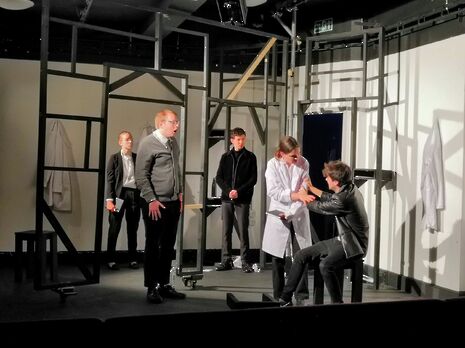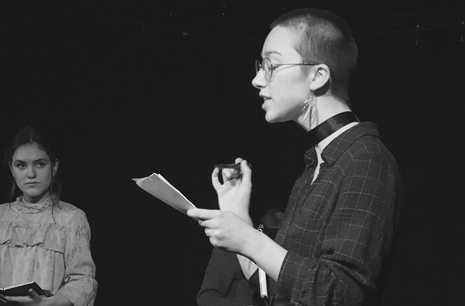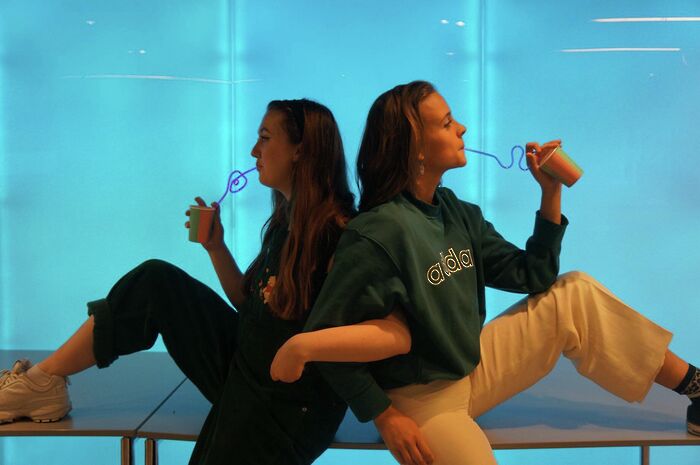The Plague review
Camus’s novel is transformed into a visceral, challenging stage adaptation

The Plague begins with a single dead rat. As one dead rat becomes ten, which becomes hundreds, then thousands, a stifling apprehension builds as trauma descends on a town. In the face of denial, fear, and futility, with spiraling escalation, comes the titular plague.
In a testimonial-type narrative, the five characters caught in the disintegration recount their experiences to unseen historians. Grand (Will Hale) is a thoughtful statistician, Cottard (Matthew Paul), his eccentric neighbor, Rambert (Anastasia Joyce), a dynamic journalist, and Tarrou (Solal Bauer), a good-natured humanitarian. The central character of the ensemble, Dr. Rieux (Sophie Kean), finds himself in the midst of it all, obligated by profession and routine to try to treat the masses and quell the chaos.
"The physicalized elements of each of these actors’ performances were executed with chilling finesse"
The original material, Albert Camus’ 1947 novel of the same name, tells the tale of the effects of a plague infecting the French Algerian city of Oran. Neil Bartlett’s 2017 stage adaptation widens the scope for a contemporary, defocused reimagining – the text, word-for-word the same as Camus’ original, but the town, now unnamed, interchangeable for anytown, allowing for an appropriation into a modern perspective. The narrative’s World War II allusionary tone, with themes of hopelessness, entrapment, and fear, now allude to more modern concerns - Bartlett poses Brexit, perhaps, but any instance of widespread xenophobic discord suffices.
Set designer Dmitry Bashtanov made clever use of the Corpus Playroom, which typically presents as a rigidly angular space. With a lattice-like, three-pronged frame, the middle of which was moved by the actors (which glided well, though often appearing precariously slanted) to create differentiating spatial compositions, from a doctor’s office, to a tenant’s room, or city streets. This, with the shadows cast by the patterned silhouette of the set piece against the walls, overlaid at times (with help of Lighting designer Lara Mandell) with a coat of blue and green lights, gave a sort of mobility and dimension to a space that can otherwise appear limitingly static.
What sounded like one repeated song (original music composed by Charlie Cumpsty) layered with the light tone of the ringing of bells, juxtaposed with devastatingly dark updates on the progress of the plague, added stark and disconcerting ominousness. Additionally, the cast’s continued note taking on the periphery and crumpling of papers to drop atop the stage provoked thought on the historicizing and documentarian nature of the narrative, the characters seemingly desperate to find the correct words to convey the extent of destruction outside of the abstract.

Co-Directors Craig Stewart and Odette Baber Straw skillfully crafted an equitably balanced five-hander, aptly allowing for gender-flipped roles to balance a technically all-male character drama. The cast cohesively carried an often arduous narrative (purposefully ambiguous, yet in its ambiguity, often becoming densely vague) with speed and precision. The intimate character work was the backbone of the play, each actor devoting themselves both characteristically and physically to the narrative through committed actions and demeanor.
Kean led the quintet with a focused meticulousness, her embattling logic and emotion conveyed with a calculated intensity to brilliant effect. Hale’s Grand was equally intense, a penultimate emotional scene showing his character bent and contorted with the will to live, sweat mixed interchangeably with tears streaming down his face, in a stunningly brutal performance. Paul’s Cottard was a hauntingly leering presence, as he muttered and wandered around the stage, often seemingly a ghostly harbinger of the destruction.
The physicalized elements of each of these actors’ performances were executed with chilling finesse, integral to bringing an otherwise abstract narrative to tangible fruition. These moments highlighted the play’s eeriness; a moment where contortions of cast members were choreographed to a child’s screams was entirely visceral and tantalizingly disconcerting.
Though, in the fashion of how the piece was imagined, the drama ended ambiguously, leaving audiences to contemplate broad questions and existential qualms of futility, denial, and hope. Despite this, The Plague was presented by a tremendous cast, in their collaboration, creating a hauntingly compelling piece.
 Comment / The (Dys)functions of student politics at Cambridge19 January 2026
Comment / The (Dys)functions of student politics at Cambridge19 January 2026 News / Local business in trademark battle with Uni over use of ‘Cambridge’17 January 2026
News / Local business in trademark battle with Uni over use of ‘Cambridge’17 January 2026 Features / Exploring Cambridge’s past, present, and future18 January 2026
Features / Exploring Cambridge’s past, present, and future18 January 2026 News / Your Party protesters rally against US action in Venezuela19 January 2026
News / Your Party protesters rally against US action in Venezuela19 January 2026 Lifestyle / Seoul food19 January 2026
Lifestyle / Seoul food19 January 2026







